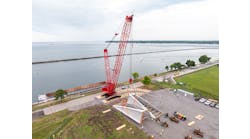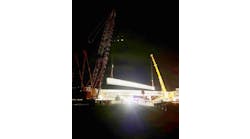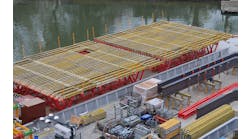By: Linda Figg and W. Jay Rohleder Jr, PR, SE
The use of concrete as a structural material has been important to sustainable infrastructure for many centuries.
Over the years concrete bridges have continued to advance through progressive concrete mix designs and bridge technologies. These advances include:
- High-performance concrete (HPC) with its many valuable benefits such as decreased permeability that impedes chloride intrusion, and improved corrosion inhibitors that provide added protection to reinforcing steel;
- Bidirectional post-tensioning in bridge decks to provide a permanent state of compression during service;
- Integral wearing surfaces for concrete bridge decks that improve long-term service performance;
- Cable-stay bridge system innovations, such as the cradle invention, and creative protection measures to provide long-term sustainability of the stays;
- Instrumentation of bridge components in service to monitor performance and provide performance feedback in real time; and
- Innovations in configuring bridge components to evenly distribute forces between elements that will contribute to improving long-term performance.
Protein for bridges
The benefits of using HPC have been widely publicized with a focus on dense concrete mixes that reduce the permeability of concrete. Reducing permeability to resist chloride penetration is provided by adding pozzolanic material, such as silica fume, fly ash or ground granulated blast furnace slag, and larger portions of cement to the concrete mix designs. This also results in higher concrete strengths, which can translate to smaller cross-sectional areas needed in design with subsequent lighter dead loads.
Bridges with concrete trapezoidal box girder superstructures and cantilever wings have routinely utilized a combination of transverse and longitudinal post-tensioning which provides a biaxial state of compressive stress in the deck. This permanent state of compression in the deck resists the formation of cracks that typically would allow chloride penetration in passively reinforced concrete decks. One of the best improvements to long-term durability would be the implementation of transverse and longitudinal post-tensioning in the concrete decks of all bridge structure types.
Going the extra depth
Bridge decks over the years have customarily used an overlay that is placed in a secondary pouring operation to serve as a sacrificial wearing surface form of deck protection. The success of applying these wearing surfaces as a secondary pour is subject to challenging ambient weather conditions and general difficulties with initial cleanliness of the deck, workmanship in placing the overlay and curing methods that can ultimately result in the formation of detrimental surface cracking. These secondary overlays sometimes experience long-term delamination that allows chlorides to be trapped in the interface between the overlay and initial deck-pour surfaces.
An alternative to the secondary application of an overlay is to include the extra depth of a sacrificial wearing surface with the initially constructed deck. This higher strength concrete and monolithic surface enhances construction and deck performance. This is known as an “integral wearing surface.” This technique was incorporated into the advanced designs of several segmental post-tensioned concrete box girder bridges, such as the Victory Bridge for the New Jersey Department of Transportation and the Susquehanna River Bridge for the Pennsylvania Turnpike Commission. This integral wearing surface is the upper 2 in. of a monolithic concrete deck protection system. The total system is 4 in. of high-quality concrete placed above the top mat of reinforcing steel and cast monolithically with the superstructure deck. This system provides ½-in. for abrasion wear, 2 in. of sacrificial wearing surface and 1½ in. of concrete cover over the top mat of reinforcing. This provides an initial high-quality wearing surface where the upper 2 in. can be removed and replaced in the future if needed.
Some advantages of using an integral wearing surface include:
- Improved quality by casting the wearing surface with precast segments in a controlled fabrication environment using higher-strength, higher-performance concrete;
- Improved durability by applying the transverse and longitudinal post-tensioning to the wearing surface;
- Reduced extreme fiber stresses in the deck by including the integral wearing surface depth into the design structural section; and
- Improved constructibility and reduced schedule by eliminating the application of a secondarily applied overlay from the critical path, since an integral wearing surface is applied during precasting operations.
Cradle safety
Another development in sustainable design is related to cable-stayed bridges that are economical for long-span crossings (600 to 1,500+ ft). The increased need to replace aging long-span bridges has drawn attention to this bridge type. This has resulted in a number of new technological innovations providing better long-term performance. One significant advancement in cable-stay technology is the FIGG-patented cradle system that has been designed and implemented on two recent bridges; the I-280 Veterans’ Glass City Skyway in Toledo, owned by the Ohio Department of Transportation, and the Penobscot Narrows Bridge & Observatory, owned by the Maine Department of Transportation.
The cable-stay cradle allows designers to:
- Install and access individual strands within a stay. This permits selective removal, inspection and replacement of strands, while the bridge is operating under full traffic service conditions;
- Allow a reduction in pylon cross-sectional dimensions for streamlined construction;
- Increase the total possible number of strands in a stay. This allows for increasing the economically feasible span length of cable-stay bridges; and
- Reduce construction time and expense with fewer operations.
The ability to individually install and remove strands in the cradle-stay system offers sustainability and long-term monitoring of the cable-stay conditions. Each stay is supplemented with extra strands, defined as “reference strands” that add extra redundancy to the system. The reference strands may be selectively removed temporarily or permanently, inspected and replaced over the service life of the bridge to provide accurate visual data about the exact strand conditions. This also has allowed for selectively substituting six of the extra steel strands with composite fiber-reinforced polymer (FRP) strands into the Penobscot Narrows Bridge cable-stay system as an experimental program for new strand materials. The practical ability for installing these FRP strands has now been successfully demonstrated and the long-term performance is being assessed as it relates to the future use of FRP strands in bridge cable stays.
Incorporating cable-stay cradles in the pylons allows for a reduction in the pylon wall dimensions, since the stay forces are transferred as compressive forces into the pylon rather than through tensile forces, as with stays that are anchored in the pylon. This allows greater freedom in creating aesthetically pleasing and slender pylon shapes of a lower construction cost. The cradle also eliminates the need for stay stressing operations high above the bridge deck, since each strand runs continuously from the bridge deck, through the cradle in the pylon and back to the bridge deck. All stressing operations take place at the bridge deck level, thereby allowing for improved quality control during installation of the stays.
FIGG, in cooperation with the FHWA and Maine Department of Transportation, also has increased the total nested levels of protection for cable stays. In addition to the conventional use of coated strands and an outer protective sheath that houses all the strands in a stay, a sealed stay system that is purged and injected with an inert low-pressure nitrogen gas has been introduced on the recently completed Penobscot Narrows cable-stayed bridge. A series of dynaforce sensors, developed by Dywidag Systems International, also are permanently installed on three strands in each stay to allow for a reading of the force at any time for data sampling of the long-term stay performance.
Strain checkups
Innovative methods for monitoring the condition of bridges also are being incorporated into bridge elements, resulting in scientific data that verifies analytical information needed to continue achieving long-lasting, beautiful bridges. For example, the Susquehanna River Bridge was instrumented with strain gauges during construction by Pennsylvania State University to obtain data that can be used to compare the actual strain performance of the bridge with the design results. Permanent strain monitoring systems also have been installed on recent cable-stay bridges designed by FIGG for long-term evaluation of performance. This assortment of feedback is valuable to enhance design methods and specifications that will assure the continued advancement of concrete bridges and their sustainability.
Remember to stretch
Over the service life of any bridge type, there is a need to recondition or replace bearings and expansion joints. Proper operation of these elements is imperative for bridges to function as designed. Innovations to these important components can reduce long-term maintenance needs. To reduce the number of bearings and expansion joints, longer continuous spans can be used on bridges.
Through refined analysis techniques, the height of elastomeric bearings can be mixed to balance the force distributions between piers with varying heights. Using concepts such as twin wall piers, bearings can be eliminated and monolithic connections can be made between piers and superstructures. The result of using innovative methods of configuring and analyzing bridge components allows for force distributions that improve long-term sustainability while simultaneously enhancing the visual appeal of bridges.
About The Author: Figg is president and CEO of FIGG, Tallahassee, Fla. Rohleder is senior vice president, project development for FIGG, Exton, Pa.


